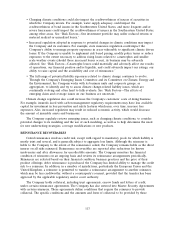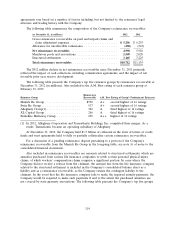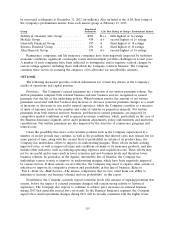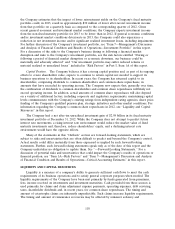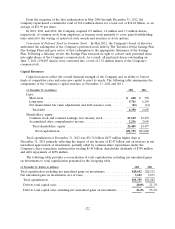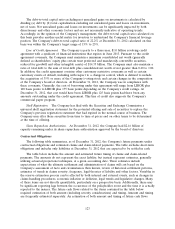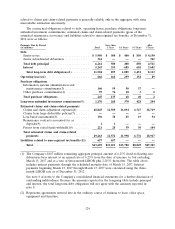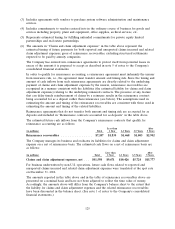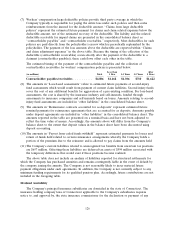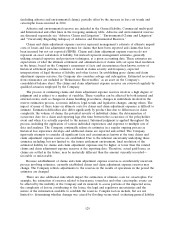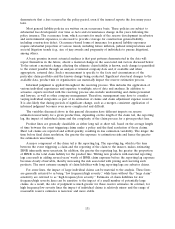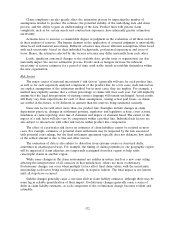Travelers 2012 Annual Report Download - page 135
Download and view the complete annual report
Please find page 135 of the 2012 Travelers annual report below. You can navigate through the pages in the report by either clicking on the pages listed below, or by using the keyword search tool below to find specific information within the annual report.The debt-to-total capital ratio excluding net unrealized gains on investments is calculated by
dividing (a) debt by (b) total capitalization excluding net unrealized gains and losses on investments,
net of taxes. Net unrealized gains and losses on investments can be significantly impacted by both
discretionary and other economic factors and are not necessarily indicative of operating trends.
Accordingly, in the opinion of the Company’s management, the debt-to-total capital ratio calculated on
this basis provides another useful metric for investors to understand the Company’s financial leverage
position. The Company’s debt-to-total capital ratio of 22.2% at December 31, 2012 calculated on this
basis was within the Company’s target range of 15% to 25%.
Line of Credit Agreement. The Company is party to a three-year, $1.0 billion revolving credit
agreement with a syndicate of financial institutions that expires in June 2013. Pursuant to the credit
agreement covenants, the Company must maintain a minimum consolidated net worth (generally
defined as shareholders’ equity plus certain trust preferred and mandatorily convertible securities,
reduced for goodwill and other intangible assets) of $14.35 billion. The Company must also maintain a
ratio of total debt to the sum of total debt plus consolidated net worth of not greater than 0.40 to 1.00.
In addition, the credit agreement contains other customary restrictive covenants as well as certain
customary events of default, including with respect to a change in control, which is defined to include
the acquisition of 35% or more of the Company’s voting stock and certain changes in the composition
of the Company’s board of directors. At December 31, 2012, the Company was in compliance with
these covenants. Generally, the cost of borrowing under this agreement will range from LIBOR plus
100 basis points to LIBOR plus 175 basis points depending on the Company’s credit ratings. At
December 31, 2012, that cost would have been LIBOR plus 125 basis points had there been any
amounts outstanding under the credit agreement. This line of credit also supports the Company’s
commercial paper program.
Shelf Registration. The Company has filed with the Securities and Exchange Commission a
universal shelf registration statement for the potential offering and sale of securities to replace the
Company’s previous registration statement that had expired in the normal course of business. The
Company may offer these securities from time to time at prices and on other terms to be determined
at the time of offering.
Share Repurchase Authorization. At December 31, 2012, the Company had $2.16 billion of
capacity remaining under its share repurchase authorization approved by the board of directors.
Contractual Obligations
The following table summarizes, as of December 31, 2012, the Company’s future payments under
contractual obligations and estimated claims and claim-related payments. The table excludes short-term
obligations and includes only liabilities at December 31, 2012 that are expected to be settled in cash.
The table below includes the amount and estimated future timing of claims and claim-related
payments. The amounts do not represent the exact liability, but instead represent estimates, generally
utilizing actuarial projections techniques, at a given accounting date. These estimates include
expectations of what the ultimate settlement and administration of claims will cost based on the
Company’s assessment of facts and circumstances then known, review of historical settlement patterns,
estimates of trends in claims severity, frequency, legal theories of liability and other factors. Variables in
the reserve estimation process can be affected by both internal and external events, such as changes in
claims handling procedures, economic inflation or deflation, legal trends and legislative changes. Many
of these items are not directly quantifiable, particularly on a prospective basis. Additionally, there may
be significant reporting lags between the occurrence of the policyholder event and the time it is actually
reported to the insurer. The future cash flows related to the items contained in the table below
required estimation of both amount (including severity considerations) and timing. Amount and timing
are frequently estimated separately. An estimation of both amount and timing of future cash flows
123


